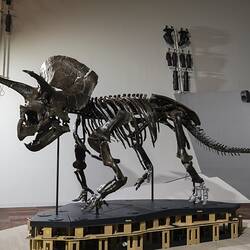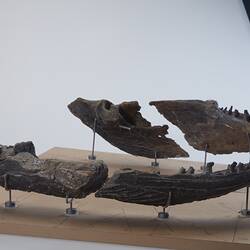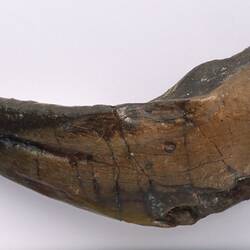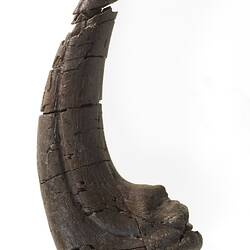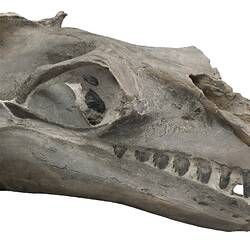Vertebrate Palaeontology
The Vertebrate Palaeontology Collection dates back to the original Palaeontology Collection of the Museum of Natural and Economic Geology (predecessor to Museums Victoria) in 1854. It houses the Museum's collection of fossils and subfossils of back-boned animals, containing representatives from 65% of all extinct and extant fish, amphibian, reptile, bird and mammal orders. The collection contains more than 130,000 specimens, including over 500 type specimens, spanning a period of 485 million years of geologic time (Ordovician to Holocene).
Specimens may be preserved as partial or nearly complete associated skeletons, isolated bones or teeth, naturally formed moulds or casts of bones and teeth, trace fossils (eg. footprints, trackways, burrows, coprolites) or replicas of other types of fossil. Associated with these specimens are images, digital data (eg. 3D surface and computed tomography scans), field notes and maps or samples of the matrix (sediment and/or rock) specimens were from. Specimens range in size from less than 1 mm to greater than 1 m, with most being 1-30 cm range.
Significance
The Vertebrate Palaeontology Collection is one of the largest vertebrate palaeontology collections in Australasia and contains the largest single collection of Victorian fossil vertebrates. It is unique amongst Australasian vertebrate palaeontology collections in terms of its breadth of sampled localities, geologic periods, and palaeoenvironments and its taxonomic coverage. The collection is of enormous value for correlating biological evolution with physical environmental drivers such as climate change over extremely long timescales, which is essential to understanding processes that shape biodiversity. It is regularly visited for research purposes by Australian and international scientists and students working on a wide range of subjects, including taphonomy, stratigraphy, palaeoecology/palaeoclimatology, biogeography, morphology, biomechanics, taxonomy, phylogenetics, evolutionary developmental biology, macroevolution and macroecology. The type collection contains specimens that form the basis for species descriptions and the comparative baseline for actions such as new or revised taxon descriptions.



